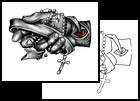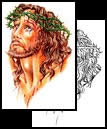|
|
|||||
 |
|||||
|
TATTOO DESIGNS & SYMBOLS - CHRISTIAN TATTOOS
Tattoo Symbol Index - A B C D E F G H I J K L M N O P Q R S T U V W X Y Z Tattoo designs - C >> Christian 
Christian Tattoo Meanings - You can credit large numbers of evangelical Christians for helping to make religious tattoos one of the most popular sectors of the current tattoo industry. Approximately 20% of the tattoos inked in North America today are religious in nature, which is to say that the wearer sees their body art as a way to get closer to their concept of God and proclaim their faith.
Symbols of Roman Catholicism are also extremely popular among certain segments of the faithful and within Latino culture you will see Rosary Beads, the Madonna, the Crucifixion, the Crown of Thorns and Sacred Hearts prominently featured along with the more standard Crosses and Angels.
A little later, during the tenth, eleventh and twelfth centuries, the Crusaders went into battle with a small cross tattooed on the back of the hand or the arm, which was a virtual lifeline to their eternal salvation. Pilgrims who made a successful pilgrimage to Jerusalem marked the occasion with a tattoo which they could then show the folks back home. The tattoo was the mark of the most faithful.
The impact and adoption of Christian symbols and designs would have been hard to restrict, in any case. Think of the Last Supper, portraits of Jesus and Mary, and of course the decorations that proliferate within the primary place of worship - indeed, God's House - the Church itself. What credible rationale could shame a believer into not wearing marks that supported their own true belief - marks and symbols that proliferated because of the patronage of the leaders of the Church? As mentioned earlier, pilgrims to Jerusalem typically tattooed themselves with the date of their pilgrimage, or had more elaborate souvenirs inked to commemorate their journey. The most common designs were St. George on a horse killing a dragon, Christ on the cross, and the Virgin Mary holding the infant Jesus. See also: Religious Tattoos, Rosary Beads, Praying Hands, Angels, Religious Tattoo Index For more info see: History of Christian Tattoos Tattoo designs - C >> Christian Tattoo Symbol Index - A B C D E F G H I J K L M N O P Q R S T U V W X Y Z |
||||
| Celeb Tattoos | Facts & Stats | Designs & Symbols | History | Culture | Links | Tattoo Galleries | Contact | |||||
|
|
|||||




